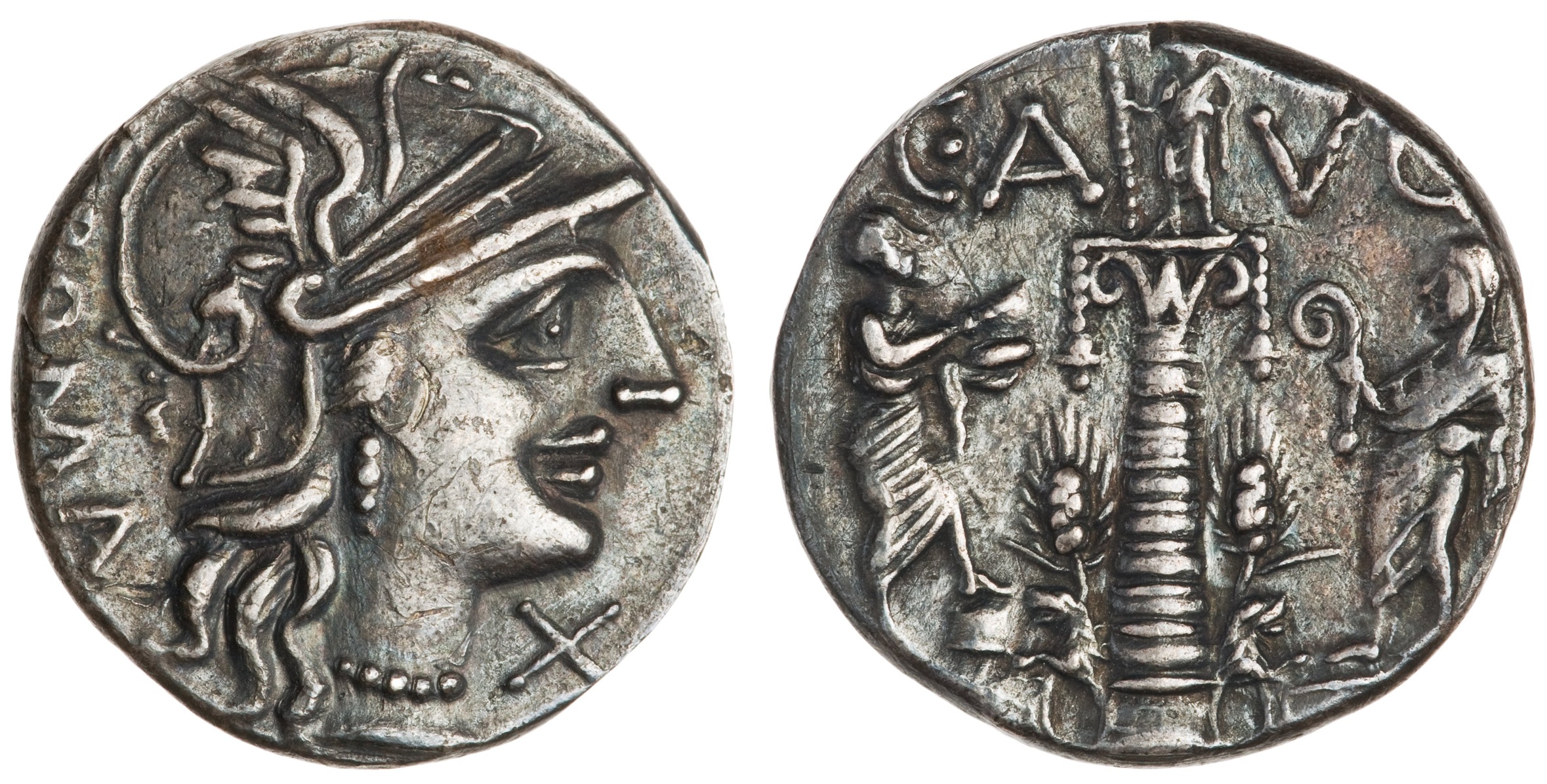Rome, silver, denarii (Roma/column with two figures) (RRC 242/1- Caius Minucius Augurinus - 135 BCE)
From SILVER
135 BCE - 135 BCE Silver 3,259 kg
Description
| ObverseInscription or printing placed on the obverse.: | ROMA behind (Latin).Head of Roma in winged helmet right, wearing pendant earring and beaded necklace, mark of value X below chin, dotted border |
| ReverseInscription or printing placed on the reverse.: | C• A-VG above (Latin).Segmented column with horizontal fluting tapering upward, surmounted by Aeolic capital supporting platform, togate figure standing half-left thereupon, grasping staff, bells depending on chains therefrom at each side, small recumbent lion foreparts facing outward at base, large free-standing grain ears therebehind, togate figure standing to right in left field, resting left foot on modius and holding loaves or cakes, veiled and togate figure standing to left in right field, holding lituus, |
Mint and issuing power
| MintIdentifies the place of manufacture or issue of a numismatic object.: | Rome | Ancient regionAncient region.: | Latium | Modern countryModern country: Italy | AuthorityIdentifies the issuing power. The authority can be "pretended" when the name or the portrait of X is on the coin but he/she was not the issuing power. It can also be "uncertain" when there is no mention of X on the coin but he/she was the issuing power according to the historical sources: | Roman Republic |
Chronology
| FromIdentifies the initial date in a range assigned in a numismatic context. | 135 BCE | toIdentifies the final date in a range assigned in a numismatic context.. | 135 BCE | PeriodTime period of the numismatic object.: Hellenistic 323-30 BC |
Physical description
| MetalThe physical material (usually metal) from which an object is made.: | Silver |
Median weightMedian of the weights of numismatic objects (in grams). in grams | 3.90 | DenominationTerm indicating the value of a numismatic object. Examples: tetradrachm, chalkous, denarius.: | denarius |
StandardStandard.: |
Image

Rome_RRC_242_1.jpg [1]
References
| Die study referencePublication of the study: | Hordies 20241Hordies 2024 | ||
| Coin series referenceReference to coin series study: | RRC2RRC, n° 242/1 | ||
| Coin series web referenceCoin series web references: | |||
Obverse dies distribution
| FrequencyFrequency of specimen in distribution. ᵖ | Number of obversesNumber of obverse dies. ᵖ (o) | % (o) | Number of coinsNumber of coins. (n) | % (n) | Die nameName(s) of the die(s). |
| 1 | 10 | 26.32 | 10 | 4.98 | 2, 6, 16, 19, 24, 34, 35, 36, 37, 38 |
| 2 | 3 | 7.89 | 6 | 2.99 | 12, 18, 29 |
| 3 | 4 | 10.53 | 12 | 5.97 | 9, 15, 22, 27 |
| 4 | 4 | 10.53 | 16 | 7.96 | 1, 17, 23, 28 |
| 5 | 2 | 5.26 | 10 | 4.98 | 13, 33 |
| 6 | 2 | 5.26 | 12 | 5.97 | 21, 30 |
| 7 | 3 | 7.89 | 21 | 10.45 | 5, 11, 25 |
| 8 | 2 | 5.26 | 16 | 7.96 | 14, 31 |
| 10 | 1 | 2.63 | 10 | 4.98 | 26 |
| 11 | 2 | 5.26 | 22 | 10.95 | 8, 10 |
| 12 | 3 | 7.89 | 36 | 17.91 | 4, 7, 32 |
| 14 | 1 | 2.63 | 14 | 6.97 | 3 |
| 16 | 1 | 2.63 | 16 | 7.96 | 20 |
| Total | 38 of 38 | 99.98 | 201 of 201 | 100.03 |
Reverse dies distribution
no distribution is available
Quantification
| Number of obversesNumber of obverse dies. ᵖ (o) | 38 | Number of singletons (o1)The number of singleton coins. ᵖ | 10 |
| Number of reverse diesNumber of reverse dies. (r) | 34 | Number of coinsNumber of coins. (n) | 201 |
| Coins per obverse dieNumber of coins per obverse die. (n/o) | 5.29 | Coins per reverse dieNumber of coins per reverse die. (n/r) | 5.91 |
| Reverse per obverse ratioRatio of obverse dies divided by reverse dies. (r/o) | 0.89 | Percentage of singletons (o1)number of coins (n) divided by the number of singletons (o1) ᵖ | 26.32 % |
| Original number of dies (O) (Carter 1983 formula)The estimation of the number of coins according to Carter 1983 ᵖ | 41.78 | Coins struck if 20,000 as average productivity per dieCoins made if the average productivity for obverses (according to Carter) is 20,000. ᵖ | 835,600 |
| Original number of dies (O) (Esty 2011 formula)The estimation of the number of coins according to the singleton formula in Esty 2011 ᵖ (O) | 46.86 | Survival rate if 20,000 as average productivity per dieSurvival rate if average productivity is 20,000. ᵖ | 0.00024 |
| Coverage (o = % of O) (Esty 1984 formula)Esty 1984 - coverage (% of O) ᵖ (o = % of O) | 95.02% | Die productivity if survival rate 1/2,000Average productivity if survival rate is 1/2,000. ᵖ | 9,621.83 |
| Weight of silver (in kg) if 20,000 coins per die (O = Carter formula)Carter 1983 * Median weight * 20000 (*10 if gold or electrum) ᵖ | 3,259 kg <br /> 3,259 kg | Die productivity if survival rate 1/5,000Average productivity if survival rate is 1/5,000. ᵖ | 24,054.57 |
Remarks
Most likely two workstations Likely military
References
- ^ Hordies, Loïc (2024), L'utilisation de la monnaie comme source: étude des caractéristiques techniques, des trésors et de l'iconographie des deniers de Caius et Tiberius Minucius Augurinus (135-134 av. J.-C.), Brussels, ULB, unpublished master degree, 159 p.
- ^ Crawford, Michael H. (1974), Roman Republican Coinage, Cambridge